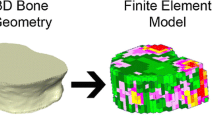Abstract
Three-point bending tests are often used to determine the apparent or effective elastic modulus of long bones. The use of beam theory equations to interpret such tests can result in a substantial underestimation of the true effective modulus. In this study three-dimensional, nonlinear finite element analysis is used to quantify the errors inherent in beam theory and to create plots that can be used to correct the elastic modulus calculated from beam theory. Correction plots are generated for long bones representative of a variety of species commonly used in research studies. For a long bone with dimensions comparable to the mouse femur, the majority of the error in the effective elastic modulus results from deformations to the bone cross section that are not accounted for in the equations from beam theory. In some cases, the effective modulus calculated from beam theory can be less than one-third of the true effective modulus. Errors are larger: (1) for bones having short spans relative to bone length; (2) for bones with thin vs. thick cortices relative to periosteal diameter; and (3) when using a small radius or “knife-edge” geometry for the center loading ram and the outer supports in the three-point testing system. The use of these correction plots will enable researchers to compare results for long bones from different animal strains and to compare results obtained using testing systems that differ with regard to length between the outer supports and the radius used for the loading ram and outer supports.





Similar content being viewed by others
References
Akhter, M. P., U. T. Iwaniec, M. A. Covey, D. M. Cullen, D. B. Kimmel, and R. R. Recker. Genetic variations in bone density, histomorphometry, and strength in mice. Calcif. Tissue Int. 67:337–344, 2000.
ANSI/ASAE. ANSI/ASAE Standard S459-FEB93 (R2007): Shear and Three-Point Bending Test of Animal Bone. American Society of Agricultural and Biological Engineers, St. Joseph, MI, 2007.
ASTM. ASTM Standard D790-2010: Standard Test Methods for Flexural Properties of Unreinforced and Reinforced Plastics and Electrical Insulating Materials. West Conshohocken, PA: ASTM International, 2010.
Burr, D. B., G. Piotrowski, and G. J. Miller. Structural strength of the macaque femur. Am. J. Phys. Anthropol. 54:305–319, 1981.
Crenshaw, T. D., E. R. Peo, Jr., A. J. Lewis, B. D. Moser, and D. Olson. Influence of age, sex and calcium and phosphorus levels on the mechanical properties of various bones in swine. J Anim. Sci. 52:1319–1329, 1981.
Currey, J. The Mechanical Adaptations of Bones. Princeton: Princeton University Press, 1984.
Danielsen, C. C., L. Mosekilde, and B. Svenstrup. Cortical bone mass, composition, and mechanical properties in female rats in relation to age, long-term ovariectomy, and estrogen substitution. Calcif. Tissue Int. 52:26–33, 1993.
Fawcett, D. W. The amedullary bones of the Florida manatee (Trichechus latirostris). Am. J. Anat. 71:271–309, 1942.
Gere, J. M., and S. P. Timoshenko. Mechanics of Materials (2nd ed.). Belmont: Wadsworth Inc, 1984.
Kohles, S. S. Applications of an anisotropic parameter to cortical bone. J. Mater. Sci. Mater. Med. 11:261–265, 2000.
Kohles, S. S., J. R. Bowers, A. C. Vailas, and R. Vanderby, Jr. Effect of a hypergravity environment on cortical bone elasticity in rats. Calcif. Tissue Int. 59:214–217, 1996.
Kourtis, L. C. Computer Tomography Based Estimation of Bone Rigidity and Strength Under Combined Bending and Torsion. PhD Thesis, Stanford University, 2011.
Kuhn, J. L., S. A. Goldstein, K. Choi, M. London, L. A. Feldkamp, and L. S. Matthews. Comparison of the trabecular and cortical tissue moduli from human iliac crests. J. Orthop. Res. 7:876–884, 1989.
Rankine, W. J. M. A Manual of Applied Mechanics. London/Glasgow: Richard Griffin and Company, 1858.
Reilly, D. T., and A. H. Burstein. The elastic and ultimate properties of compact bone tissue. J. Biomech. 8:393–405, 1975.
Roark, R. J., and W. C. Young. Formulas for Stress and Strain (5th ed.). New York: McGraw-Hill, 1975.
Schriefer, J. L., A. G. Robling, S. J. Warden, A. J. Fournier, J. J. Mason, and C. H. Turner. A comparison of mechanical properties derived from multiple skeletal sites in mice. J. Biomech. 38:467–475, 2005.
Timoshenko, S. On the correction factor for shear of the differential equation for transverse vibrations of bars of uniform cross-section. Philos. Mag. 41:744–746, 1921.
Timoshenko, S. P. Strength of Materials, Part I. Elementary Theory and Problems. New York: van Nostrand, 1958.
Timoshenko, S. P., and J. N. Goodier. Theory of Elasticity (3rd ed.). New York: McGraw-Hill, 1970.
Turner, C. H., and D. B. Burr. Experimental techniques for bone mechanics. In: Bone Mechanics Handbook, edited by S. C. Cowin. Boca Raton: CRC Press, 2001, pp. 7-1–7-35.
van Lenthe, G. H., R. Voide, S. K. Boyd, and R. Muller. Tissue modulus calculated from beam theory is biased by bone size and geometry: implications for the use of three-point bending tests to determine bone tissue modulus. Bone 43:717–723, 2008.
Wergedal, J. E., M. H. Sheng, C. L. Ackert-Bicknell, W. G. Beamer, and D. J. Baylink. Genetic variation in femur extrinsic strength in 29 different inbred strains of mice is dependent on variations in femur cross-sectional geometry and bone density. Bone 36:111–122, 2005.
Author information
Authors and Affiliations
Corresponding author
Additional information
Associate Editor Scott I Simon oversaw the review of this article.
Rights and permissions
About this article
Cite this article
Kourtis, L.C., Carter, D.R. & Beaupre, G.S. Improving the Estimate of the Effective Elastic Modulus Derived from Three-Point Bending Tests of Long Bones. Ann Biomed Eng 42, 1773–1780 (2014). https://doi.org/10.1007/s10439-014-1027-3
Received:
Accepted:
Published:
Issue Date:
DOI: https://doi.org/10.1007/s10439-014-1027-3




